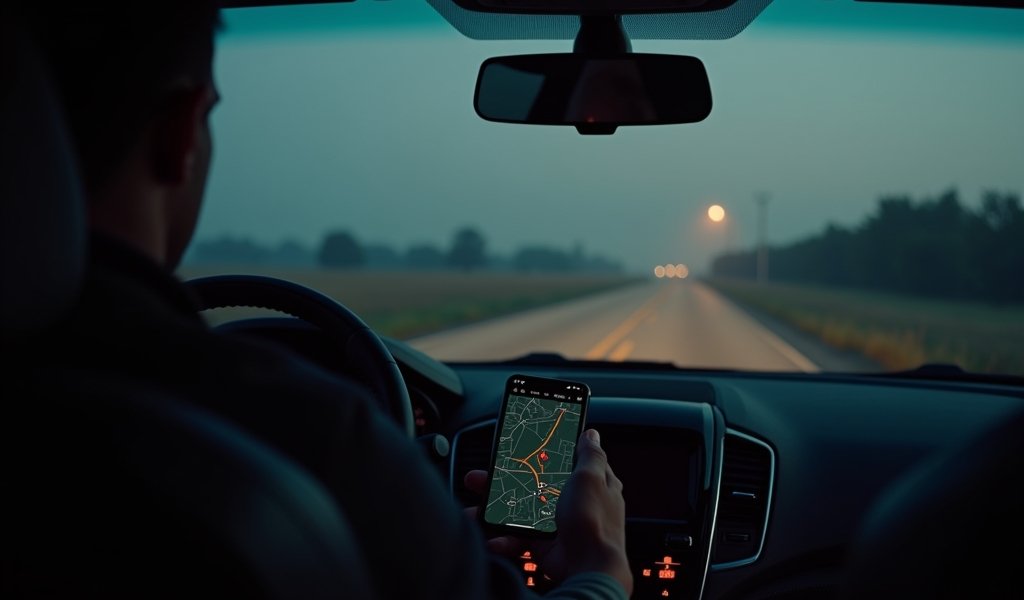Overview
This article explores the essential nature of offline navigation apps for drivers, highlighting five top options (Google Maps, HERE WeGo, Maps.me, OsmAnd, and Sygic) while providing detailed instructions for downloading maps, maximizing the offline experience, and selecting the right app based on storage requirements, battery efficiency, and unique features. The guide emphasizes the importance of preparation before traveling to areas with poor connectivity, international destinations, or during emergencies, positioning offline navigation as a crucial tool that ensures continuous guidance regardless of data availability.
Table of Contents
- Why Every Driver Needs Offline Navigation
- Best Navigation Apps That Work Without Data
- How to Download Maps for Offline Use
- Maximizing Your Offline Navigation Experience
- Real-World Applications: When Offline Navigation Saves the Day
- Comparing Features: Finding Your Perfect Navigation Companion
- Conclusion: Navigate Confidently Anywhere
- Frequently Asked Questions
Why Every Driver Needs Offline Navigation
We’ve all been there – driving along a scenic route when suddenly your navigation app freezes with the dreaded “No Service” message. In that moment, you realize how dependent we’ve become on constant data connectivity for something as fundamental as finding our way.
Navigation apps without data usage aren’t just convenient – they’re essential tools for modern drivers. Whether you’re heading into remote areas, traveling internationally, or simply trying to conserve your data plan, offline navigation capabilities ensure you never lose your way, regardless of signal strength.
As someone who’s spent years guiding drivers through both mechanical and technological challenges, I can tell you that offline navigation offers several critical advantages:
- Reliable guidance through areas with poor or no cell coverage
- Significant data savings on your mobile plan
- Freedom from expensive international roaming charges
- Better battery life compared to constantly streaming map data
- Emergency navigation during network outages or disasters
Think of offline maps as the spare tire of digital navigation – you might not need them every day, but you’ll be incredibly thankful they’re there when circumstances demand them. Let’s explore how to equip your digital toolbox with the right navigation solutions for any journey.
Best Navigation Apps That Work Without Data

After testing dozens of navigation apps in various conditions – from desert backroads to dense urban centers with poor connectivity – I’ve identified the most reliable options that function perfectly without data. Here’s my breakdown of the top contenders:
Google Maps
The navigation giant many of us already use offers surprisingly robust offline capabilities. While not as full-featured without data, its familiarity makes it a comfortable starting point for offline navigation.
Google Maps allows you to download specific regions before your trip. Once downloaded, you’ll have access to turn-by-turn driving directions, basic search functionality, and limited business information within that area – all without using a single byte of data.
What I appreciate most is how seamlessly it transitions between online and offline modes. The app will automatically use your downloaded maps when connectivity drops, often without you even noticing the switch.
HERE WeGo
Originally developed by Nokia, HERE WeGo has evolved into perhaps the most comprehensive offline navigation solution available. What sets it apart is the completeness of its offline experience.
With HERE WeGo, you’re getting full voice guidance, detailed points of interest, and even public transit information in many cities – all functioning without data. The app excels in urban environments where detailed navigation cues make all the difference.
I’ve found its search functionality while offline to be particularly impressive. You can search for specific businesses or addresses within your downloaded regions almost as effectively as you would with full connectivity.
Maps.me
A favorite among international travelers, Maps.me leverages OpenStreetMap data to provide extremely detailed maps worldwide. What makes it stand out is the incredible detail in its offline maps, often including trails, small businesses, and points of interest that larger providers might miss.
The app’s bookmark system is perfect for trip planning. You can mark accommodations, attractions, and other points of interest in advance, creating a personalized travel guide that works completely offline.
As a bonus, Maps.me’s file sizes are remarkably compact compared to competitors, making it ideal if you’re short on device storage but need coverage for multiple areas.
OsmAnd
For the technically inclined driver who wants maximum customization, OsmAnd offers unparalleled flexibility. Based on OpenStreetMap data, it provides incredibly detailed maps with specializations for various activities.
What distinguishes OsmAnd is its specialized mapping options. Beyond standard road navigation, it offers dedicated maps for hiking, cycling, and even nautical usage. The app also excels at offline navigation for driving in remote areas where detailed topographical information matters.
While its learning curve is steeper than other options, the payoff in functionality makes it worth considering, especially for adventurous drivers who frequently venture off the beaten path.
Sygic
Sygic takes a premium approach to offline navigation with a focus on driver-friendly features. Its realistic 3D mapping with landmarks makes orientation intuitive, even in complex urban environments.
The app’s strong suits include lane guidance at complicated intersections, speed limit warnings, and camera alerts – all functioning without data connection. It also offers parking suggestions near your destination, a godsend in unfamiliar cities.
While Sygic requires a paid subscription for full functionality, many drivers find the investment worthwhile for its polished user experience and comprehensive feature set.
How to Download Maps for Offline Use
Having the right app is only half the battle – properly downloading and managing your offline maps is equally important. Here’s a straightforward guide to setting up offline navigation on the major platforms:
Google Maps
- Open Google Maps while connected to Wi-Fi
- Tap your profile picture in the upper right corner
- Select “Offline Maps” then “Select Your Own Map”
- Adjust the area by pinching and zooming until you’ve covered your needed region
- Tap “Download” (check the file size before confirming)
Pro tip: Name your downloaded maps descriptively (e.g., “Yosemite Trip 2023” rather than “Map 1”) to easily find them later. Google Maps will automatically update your offline maps when you’re connected to Wi-Fi, ensuring you have current information.
HERE WeGo
- Launch HERE WeGo with an internet connection
- Tap the menu button and select “Download Maps”
- Choose a continent, then select a country or region
- Tap “Download” to save the map to your device
HERE WeGo typically organizes maps by country or state/province, making it easy to manage larger regions. Unlike Google Maps, these maps don’t expire automatically, so remember to manually update them occasionally for the latest road information.
Maps.me
- Download and open the Maps.me app
- The app will immediately suggest downloading the map for your current location
- For other areas, search for a city or region
- When viewing an area without downloaded data, you’ll be prompted to download it
What I appreciate about Maps.me is its straightforward approach – the app is designed primarily for offline use, so the download process is seamlessly integrated into the normal workflow.
OsmAnd
- Open OsmAnd and navigate to “Maps & Resources”
- Select the “Local” tab and tap “Download Maps”
- Choose regions by continent and country
- Select specific regions or entire countries
OsmAnd offers the most customizable download options. Beyond standard maps, you can separately download contour lines for elevation data, Wikipedia points for sightseeing, and various specialized map types depending on your needs.
Sygic
- After installing Sygic, you’ll be prompted to download maps immediately
- Select the continent, then country or region
- Download over Wi-Fi (maps are typically large, often exceeding 1GB for entire countries)
Given their size, Sygic maps require planning ahead. The detailed 3D rendering requires more storage space, but delivers a more immersive navigation experience as compensation.
Maximizing Your Offline Navigation Experience
After years of helping drivers optimize their vehicle technology, I’ve developed some practical strategies to get the most from offline navigation. These tips can make the difference between a smooth journey and a frustrating experience:
Plan Like a Navigator of Old
Before modern GPS, travelers studied maps carefully before departure. Apply this same diligence with your offline maps. While connected to Wi-Fi, explore your route, mark key waypoints, and familiarize yourself with the general path. This advance preparation can prevent confusion when you’re on the road without data assistance.
I recommend setting waypoints for gas stations, rest areas, and emergency services along your route. These digital breadcrumbs provide peace of mind when traveling through unfamiliar territory.
Strategic Downloading
Don’t wait until you’re about to lose signal to remember you need offline maps. Download maps at least a day before your trip while on a stable Wi-Fi connection. Consider these guidelines for smart downloading:
- Always download slightly more area than you think you’ll need
- Include neighboring regions if your route passes near boundaries
- For international trips, download maps for connecting airports and transit areas
- Check download sizes – most regional maps range from 200MB to 1GB
When traveling to truly remote areas, I recommend having maps from two different providers. This redundancy ensures you have a backup if one app has incomplete information for a particular region.
Battery Preservation Tactics
Navigation apps are notorious battery drains, and this can be even more problematic in areas without connectivity where you might need your phone for emergency purposes. Implement these power-saving strategies:
- Carry a reliable car charger or power bank
- Reduce screen brightness when possible
- Close background apps to reduce system load
- Consider putting your phone in power-saving mode
- Use a phone mount to keep your device visible without holding it
Some apps like OsmAnd offer specific settings to reduce battery consumption during navigation. Explore these options before embarking on extended trips.
Keep Your Maps Fresh
Roads change, businesses relocate, and construction projects alter familiar routes. I’ve seen too many drivers frustrated by outdated information that led them to closed roads or relocated businesses. As a rule of thumb:
- Update city maps every 3-6 months
- Refresh maps for rapidly developing areas more frequently
- Always update maps immediately before major trips
- Delete unused maps to free up device storage
According to US Department of Transportation data, approximately 2-3% of road networks change annually in developed areas, with even higher rates in growing regions.
Real-World Applications: When Offline Navigation Saves the Day

To appreciate the true value of offline navigation, let’s explore some real-world scenarios where it proves indispensable:
The Scenic Route Through Dead Zones
Picture this: You’re driving through the stunning landscapes of a national park or mountain range. Cell towers are sparse, and coverage disappears for stretches of 50+ miles. With offline maps, your navigation continues seamlessly as you wind through valleys and passes.
I recently traveled through parts of the American Southwest where cell coverage was virtually non-existent for hours at a time. Having the entire region pre-downloaded meant I could confidently take scenic detours knowing my navigation would continue functioning regardless of connectivity.
International Travel Without Bill Shock
Imagine landing in Tokyo, Barcelona, or Cairo, eager to explore. Without offline navigation, you’d face a difficult choice: pay exorbitant international data rates or fumble with paper maps in an unfamiliar city.
During a recent European trip, I relied entirely on offline maps for three weeks across five countries. Not only did this save hundreds in potential roaming charges, but it also provided consistent navigation through rural areas where coverage was spotty at best.
Disaster Scenarios and Emergency Navigation
When natural disasters strike, network infrastructure is often among the first systems to fail. Hurricane evacuations, wildfire escape routes, and flood detours become critically important exactly when cell networks may be overwhelmed or damaged.
The Federal Emergency Management Agency (FEMA) recommends having offline navigation capabilities as part of your emergency preparedness plan, particularly for residents in disaster-prone regions.
The Data Conservation Strategy
Even in well-connected areas, continuous navigation consumes surprising amounts of data. A two-hour daily commute using online navigation can easily consume 2-3GB of data monthly. Using offline navigation for routine trips preserves your data allowance for when you truly need connectivity.
This strategy is particularly valuable for those with limited data plans or in areas where mobile data is expensive. The savings add up significantly over time.
Comparing Features: Finding Your Perfect Navigation Companion
Each offline navigation app has its own strengths and specialties. Understanding these distinctions can help you choose the right tool for your specific needs:
Storage Requirements
Device storage is a finite resource, and offline maps can consume significant space. Here’s how the major apps compare:
- Google Maps: Moderate (200-300MB per metropolitan area, 500MB-1GB for larger regions)
- HERE WeGo: High (entire states/countries, often 500MB-1.5GB)
- Maps.me: Low (compressed data, typically 50-200MB per region)
- OsmAnd: Variable (highly customizable downloads, base maps plus optional add-ons)
- Sygic: High (detailed 3D renders require space, often 1GB+ per country)
If you’re tight on storage, Maps.me offers the best balance of detailed mapping with minimal space requirements. For those with ample storage, Sygic’s rich visuals may be worth the extra space.
Battery Efficiency
Navigation is inherently power-intensive, but some apps manage resources better than others:
- Google Maps: High consumption (especially with screen always on)
- HERE WeGo: Moderate consumption
- Maps.me: Low to moderate consumption
- OsmAnd: Low consumption (with battery optimization settings enabled)
- Sygic: Moderate to high consumption (3D rendering requires more power)
For long journeys where power conservation is critical, OsmAnd offers the best efficiency once properly configured. Its power-saving options can extend battery life significantly compared to more resource-intensive alternatives.
Ease of Use
The best navigation app is one you can operate safely while driving, with minimal distraction:
- Google Maps: Excellent (familiar to most users, intuitive interface)
- HERE WeGo: Good (clean design, straightforward controls)
- Maps.me: Good (simple but sometimes cluttered with POIs)
- OsmAnd: Fair (powerful but complex for beginners)
- Sygic: Very Good (driver-oriented interface with clear visuals)
For less tech-savvy drivers, Google Maps provides the gentlest learning curve. For those willing to invest time mastering a more complex interface, OsmAnd offers unmatched customization.
Unique Strengths
Each app has specialized capabilities that might make it the perfect choice for specific scenarios:
- Google Maps: Best integration with Google search and services
- HERE WeGo: Superior public transit guidance and urban navigation
- Maps.me: Best for travelers (detailed hotel/attraction bookmarking)
- OsmAnd: Unmatched for outdoor activities and specialized mapping
- Sygic: Premium driving features (lane guidance, speed alerts, realistic views)
Many experienced travelers maintain multiple navigation apps, selecting the most appropriate tool based on their specific journey. This hybrid approach ensures you’re never without suitable guidance.
According to research from Consumer Reports, using the right navigation tool for each specific situation not only improves efficiency but can also enhance driving safety by reducing distraction.
Conclusion: Navigate Confidently Anywhere
In our hyperconnected world, it’s easy to forget that data dead zones still exist – often in the most beautiful and memorable places you’ll visit. Preparing your navigation tools for offline use isn’t just about saving data costs; it’s about ensuring your freedom to explore with confidence.
Based on my experience, I recommend most drivers maintain at least two offline navigation solutions:
- Google Maps or HERE WeGo for general navigation and familiar areas
- Maps.me or OsmAnd for more detailed mapping in remote or international locations
Remember that the most crucial step is downloading your maps before you need them. Just as you wouldn’t start a road trip with an empty gas tank, don’t begin your journey without proper navigation preparation.
The freedom of the open road beckons, and with the right offline navigation tools at your disposal, you can answer that call without worry – regardless of whether those signal bars show full strength or none at all.
Safe travels, and may your journeys be as smooth as a freshly paved highway!
Frequently Asked Questions
How much storage space do offline maps typically require?
Offline maps generally require between 200MB-1GB per region, depending on the app and area size. City maps are smaller (100-300MB) while entire countries can exceed 1GB.
Do offline maps provide turn-by-turn voice navigation?
Yes, most offline navigation apps including Google Maps, HERE WeGo, and Sygic provide complete turn-by-turn voice guidance without data. The voice prompts function identically to online navigation.
How often should I update my offline maps?
Update your offline maps every 3-6 months for regular use, and always before major trips. Areas with rapid development or construction may require more frequent updates.
Will offline navigation apps show traffic conditions?
No, real-time traffic information requires a data connection. Offline maps can provide routing but cannot display current traffic conditions, accidents, or temporary road closures.
Can I search for businesses and addresses while using offline maps?
Yes, most offline navigation apps allow searching within downloaded map areas. The search capabilities vary by app, with HERE WeGo and Maps.me offering particularly robust offline search functionality.

